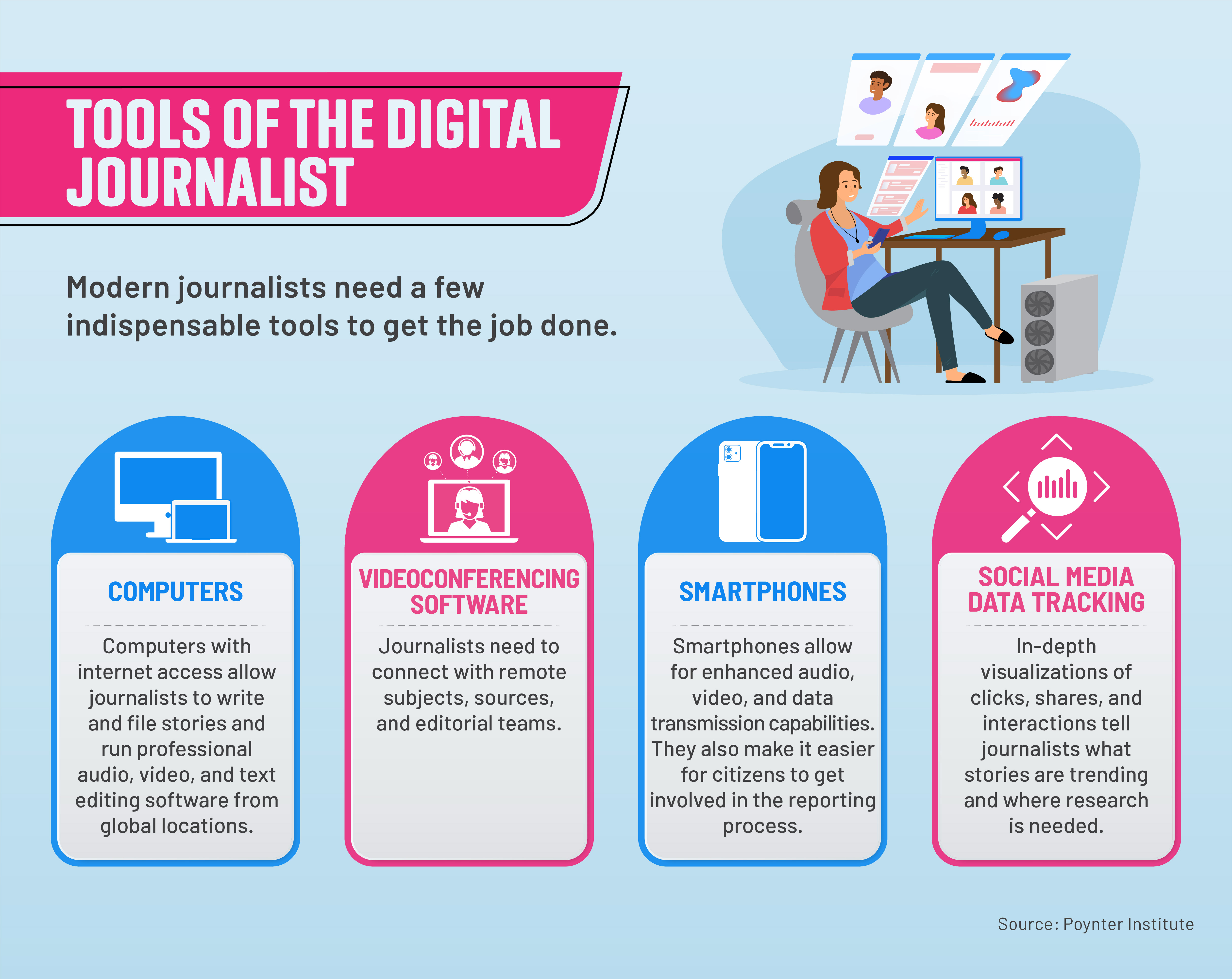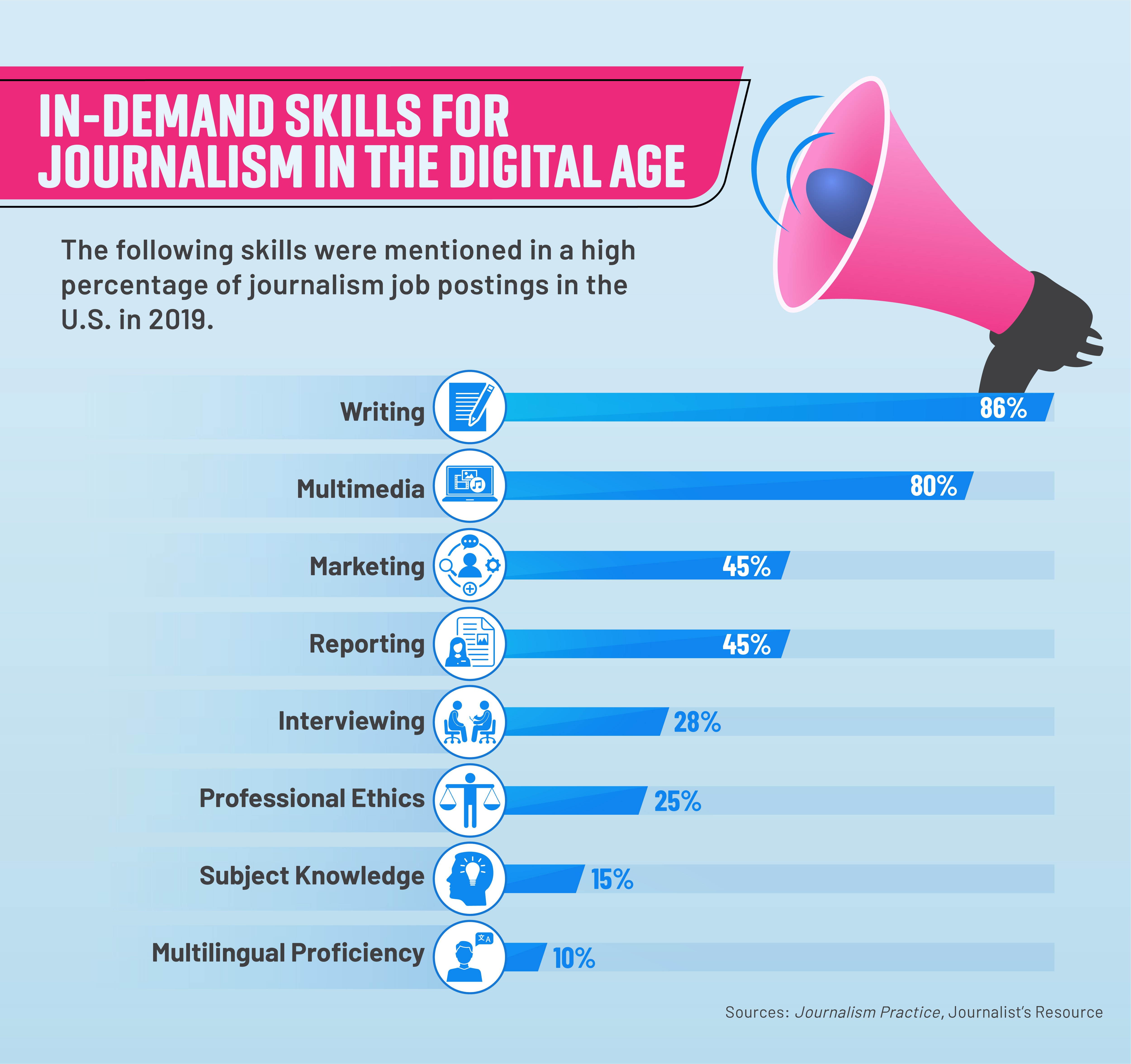The Rise of Digital Journalism: Past, Present, and Future

Tables of Contents

Advanced communication is one of the things that set humans apart from the rest of the animal kingdom. No other species communicates with the depth and complexity we do. We’ve developed more and more intricate ways to express ourselves, from cave paintings to the written word and illuminated manuscripts to Twitter, the telephone, and FaceTime.
The 20th and 21st centuries have revolutionized how humans communicate, accelerating a process hundreds of thousands of years in the making and launching it forward with astonishing speed. Just a few centuries after books became widespread, people are now walking around with devices capable of connecting them with anybody around the world in a matter of seconds.
Communication advancements have revolutionized the field of journalism, as journalists and reporters around the world operate in ways almost unrecognizable from the profession of a century ago. As the 21st century marches on, different types of journalists and media outlets will continue to evolve in response to digital journalism trends.
The Evolution of Modern Journalism in America
Though the spirit of journalism was alive before and during the American Revolution — Benjamin Franklin was a famous early newspaper printer — independent newspapers with full-time reporters didn’t emerge until the 19th century. The concept of popular media developed during the 1900s, starting with radio and newspapers in the first half of the century, before television’s domination in the 1950s. The ability for average citizens to bring the world into their living room became an irresistible and integral part of American culture and home life, with families gathering around the tube to watch everything from the moon landing to MTV.
The turn of the 21st century saw the rise of a new journalism medium for a new millennium: the internet. Another major development was the proliferation of different media and distinct voices. The omniscient, “objective” news bureaus of the three major networks dominated American television news, but that quickly fractured into a range of cable channels, internet sites, and social media feeds.
Revolutionizing global commerce and communication seemingly overnight, the internet has also fundamentally changed how journalists and media outlets operate. Old-school journalism outlets have found it difficult to adjust, but newer types of journalism have flourished in a media landscape that’s almost unrecognizable from a few decades ago.
What Is Journalism in the Digital Age?
Journalism has changed rapidly in the late 20th and early 21st centuries. The traditional ideal of journalism was for reporters to serve as independent sources, attempting to deliver the news in a fact-based, objective manner. While this tradition remains intact in some news avenues, increased access to technologies has led to the proliferation of citizen and activist journalists who openly have a bias or point of view, but still attempt to promote that perspective through a lens that includes fair framing, editing, and reporting.
Some also take advantage of these technologies to advance propaganda under the guise of news. In addition, the internet has allowed for all of us to become authors: Anyone can create a blog and put an opinion out into the world, where it can go viral without any fact-checking or editing.
Journalists in the digital age must operate in a world where the news cycle moves faster. As a result, striking a balance between timely and in-depth reporting is often more difficult.

Modern journalists need a few indispensable tools to get the job done. Computers: Computers with internet access allow journalists to write and file stories and run professional audio, video, and text editing software from global locations. Videoconferencing software: Journalists need to connect with far-flung subjects, sources, and editorial teams. Smartphones: Smartphones allow for enhanced audio, video, and data transmission capabilities. They also make it easier for citizens to get involved in the reporting process. Social media data tracking: In-depth visualizations of clicks, shares, and interactions tell journalists what stories are trending and where research is needed.
To facilitate speedy, accurate reporting, modern journalists use various recent inventions and innovations:
- Internet: Before the digital age, reporters had to either call in their stories or drive to the newsroom to type it out, and then submit it to their editors; after that, the story would have to find its way to the printing press. Now, the internet means journalists can file stories on location from a phone or laptop, allowing organizations to get breaking news on their websites within minutes of it happening.
- Specialty software: Modern programs and apps allow journalists to do everything from video editing to graphics work, research, and transcription from the comfort of their living rooms.
- Videoconferencing software: Applications like Zoom and Google Meet allow journalists to conduct interviews and staff meetings remotely.
- Smartphones: Arguably the most important tool in modern journalism is the smartphone, most commonly iPhones and Android devices. Capable of shooting images and video, recording audio, accessing the internet, and more, journalists can produce professional work using nothing other than their smartphones.
- Social media: Journalists use social media networks, such as Twitter, Instagram, and Facebook, to promote their work, stay on top of breaking news, seek sources, and interact with the public.
- Digital recorders and transcription services: In the early days of modern journalism, reporters had to rely on shorthand to accurately quote a subject, not an easy task when listening to a politician’s speech or a star player’s postgame interview. Now, recorders that cost less than $100 can easily record, store, sort, and play back dozens of hours of audio on a single charge, and advanced voice-recognition software can generate transcripts from audio files with increasing accuracy.
- Digital cameras (dual purpose): When cameras were film-based only, journalistic photography was an expensive, time-consuming practice reserved almost solely for professionals. Now, with the proliferation of digital and smartphone cameras, almost everybody has a dual-purpose device that can take both high-definition photographs and video. Most professionals still rely on more advanced digital single-lens reflex (DSLR) cameras and newer mirrorless digital cameras, which come with interchangeable lens systems that allow the cameras to shoot everything from close-ups to a football field far away.
The State of Modern Journalism in America
Even in a country such as the U.S. that legally protects freedom of the press, journalism jobs around the country have drastically declined. Pew Research reports that American newspapers lost half their newsroom employees between 2008 and 2019, with journalism as a whole losing 23% of newsroom jobs. The jobs that remain are typically low-paying, with half of all journalists making less than $40,000 a year, despite often putting in more than the typical 40-hour workweek.
One of the largest contributing factors to newsroom decline in the U.S. was a bad gamble on the newspaper industry’s part. When newspapers first started putting their content online, they did so for free, assuming that online advertising revenue would make up for the loss of subscribers and in-person newspaper sales. However, that revenue was nowhere near as lucrative as expected, and when outlets pivoted to paywalls, their readers balked, now used to getting the product for free and therefore unwilling to pay for it.
As a result, there has been increased industry consolidation as large conglomerate companies, such as Sinclair Media and Alden Global Capital, purchase smaller news outlets struggling to make a profit. In some cases, these conglomerates have used their vast networks to push their own viewpoints via content that can border on propaganda. Many of these conglomerates have a reputation for cutting jobs to turn a profit.
More recently, the COVID-19 pandemic has hurt many industries, including journalism. Many smaller news outlets have closed during the pandemic, and even larger news providers have had to scale back due to revenue loss and a decline in news events to cover (such as sports and live entertainment events). With so many people stuck at home, however, broadcast and online outlets have thrived, as have social media news reporters, who have been best positioned to pivot and respond to the new reality.
How Different Types of Journalism Adjusted to the Digital Age
The U.S. Bureau of Labor Statistics (BLS) reports that there were 52,000 reporters, correspondents, and broadcast news analysts in 2019. There were also 118,700 editors, 35% of whom worked for newspaper and other print media publishers. However, the field of journalism comprises numerous different subspecialties, all of which require different skill sets, tools, and approaches.
No matter the role, the digital journalism era has brought wholesale changes to the industry. Here’s how the digital age has affected different types of journalism roles and how they’ve adjusted.
Traditional Journalism
In what’s known as traditional journalism, newspaper reporters and editors work for a local paper of record, the primary paper in a town or an area. In the nation’s capital, it’s The Washington Post; in the City of Angels, it’s the Los Angeles Times. Regardless of location, the newspapers have an established history of professional news reporting, a neutral political stance, and thorough coverage of their regions.
Most traditional journalism outlets were too slow to respond to the digital age, and have suffered for it. The BLS expects both reporting and editorial jobs in newspapers to decline by 40% over the next 10 years, and small papers across the U.S. are shutting down or reducing operations seemingly every day. Declining advertising revenue, the loss of the classifieds section to the internet, and increased costs have forced many news outlets to slash their staff or sell outright to conglomerates such as Gannett or Advance Publications, which often downscale the publications anyway.
Broadcast and Cable Journalism
Since radio’s invention in the early 20th century, American families have welcomed broadcasters into their homes. From Edward R. Murrow and Walter Cronkite to Rachel Maddow and Anderson Cooper, top broadcast journalists command audiences of millions who tune in for their knowledge and authoritative voices on the nation’s news and current affairs. According to the BLS, about 17,000 journalists worked in broadcast as of 2019, making up 32% of the jobs within the reporters and correspondent categories.
Broadcast and cable are still relevant, with leading anchors drawing millions of viewers, whether for afternoon political shows or programs such as 60 Minutes. That doesn’t mean that the digital transition hasn’t affected broadcast journalism. Television news has embraced infotainment as it competes for viewers, showcasing stories that engage emotion and outrage over drier, policy-driven ones with far greater real-world impact.
At the same time, comedians such as Stephen Colbert and Samantha Bee further obscure the old lines with current events comedy shows that some feel follow journalistic standards of research and fact-checking more rigorously than news channels such as Fox News and MSNBC.
The rise of independent broadcast outlets has also challenged broadcast journalism. Streaming apps such as Facebook Live and Twitch allow citizen journalists and entrepreneurial journalists to spread compelling, high-definition video and attract big audiences in the span of a few minutes. National protests such as the George Floyd marches in 2020 and the U.S. Capitol riot in January 2021 were both extensively covered by citizen journalists, who captured never-before-seen angles of social unrest and social commentary from the center of the action.
Investigative Journalism
The 2015 Academy Award winner for best picture, “Spotlight,” told the true story of the Boston Globe’s investigative team as it investigated the Catholic Church abuse scandal that rocked the city at the turn of the 21st century. It was a compelling portrayal of how the team went to great lengths to convince dozens of abuse victims to come forward with their stories, and how the team spent hours digging through volumes of physical directories and microfiche records from the print and electronic ages.
Investigative journalism in the digital age has come to lean on new tools. A major development has been the rise of big data. The ability to comb through years of financial data, browsing history, cellphone logs, and all sorts of other data sets gives investigative journalists endless amounts of information to analyze to put together their stories.
Sports Journalism
Americans love sports. Whether it’s a professional league such as the NFL or WNBA or a beloved local high school team, people love following their favorite teams and players. Sportswriters from Grantland Rice to Michael Lewis have left their mark on American culture through their writing, and the best writers at many local papers are in the sports section, shining a light on local athletes.
ESPN was the first major disruptor in sports journalism. In the late 20th century, the Connecticut-based company quickly became the dominant force in American sports coverage. ESPN’s networks, although still the biggest names in sports, have seen their online presence hurt by the arrival of new players, such as the subscription sports site The Athletic, which has quickly become the go-to digital news media site for sportswriters. With athletes now also reaching customers directly through sites such as The Players’ Tribune and social media accounts, sports journalists have branched out into analytics and long-form journalism to stay relevant.
Print News
Outside of newspapers, journalists work in magazines, tabloids, and other print publications. The publications are often among the hardest hit in the industry, with high printing costs for color pages and full-bleed photos, along with high costs for quality writers who often produce long features that take weeks or months to complete.
Long-form journalism of the type that traditionally appeared in magazines has moved onto sites such as The Athletic or Medium. Former powerhouse magazines, from Newsweek and Time to GQ to Sports Illustrated, have all had to cut back on staff and the size of their product and increasingly pivot to an online format to try and stay afloat, leading some to wonder how much longer magazines will be around.
Social Media News
Social media journalists have only existed since the rise of digital journalism. The first social media journalists started appearing on sites such as Facebook and Twitter, but now work on photo sites such as Instagram and specialty platforms such as Signal and VSCO as well.
Social media journalists are learning to grow with the times: As new platforms emerge and attract users, social media journalists evaluate whether it benefits their personal brand to build a following there. They’ve also found ways to monetize their work through advertisements, sponsored posts, or paywalls that reserve content for subscribers through services such as Patreon.
Resources: Defining Journalism Jobs
- The Balance Careers, “What Does a TV Reporter Do?” — A brief rundown of broadcast journalism
- The Balance Small Business, “Understanding the Role of a Social Media Reporter” — A discussion of the profession and its key skills, including how they differ from traditional journalism
- Konrad Adenauer Stiftung, “Investigative Journalism Manual” — An in-depth examination of what it takes to become an investigative journalist, from identifying a story and developing research to interviewing subjects and writing a piece
- Houston Chronicle, “How to Become a Sports Reporter” — The path to becoming a sports reporter and the skills required to land the job
- Houston Chronicle, “Job Requirements to Be a Print Journalist” — The education, experience, and skills it takes to make it in the world of print
- KRTV, “A Day in the Life of a Reporter” — An inside look at a TV reporter’s daily routine

The following skills were mentioned in a high percentage of journalism job postings in the U.S. in 2019: writing, 86%; multimedia, 80%; marketing, 45%; reporting, 45%; interviewing, 28%; professional ethics, 25%; subject knowledge, 15%; multilingual proficiency, 10%.
Digital Journalism Skills
Having a smartphone and the right editing software is a good way to start off in the field of modern journalism. However, tools without the ability and know-how to use them won’t matter much in an ultracompetitive field. Some skills that can help lead to a career as a journalist in the digital age are:
- Investigation: At its core, journalism is a storytelling profession, and the best stories aren’t always obvious. They often require hours of interviews, chasing down sources and leads, going down dead ends, and trying new paths. Whether working for a major news organization or paving their own route, the ability to hit on a story and track it to its conclusion is the hallmark of good journalists.
- Research: Research and investigation, although cut from the same cloth, are different skills. While investigators track down leads and work sources for new information, research involves studying books, old newspapers, and other media as background for stories. Like investigations, research stages can take weeks or months to discover a story’s full background, or to gain a proper appreciation of the bigger picture.
- Written communication: You can be a great interviewer or video editor, but without the ability to write a compelling script or story, technical abilities won’t matter. Writing will always remain a central tenet of journalism, and the best journalists all have the ability to file a strong story on deadline, even if their focus is in a different area.
- Basic web design: Using programs such as Adobe Photoshop, Adobe InDesign, and Adobe Illustrator, journalists can create graphics, video backgrounds, illustrations, and data visualizations to supplement their work. Although blogging platforms make it easy for independent journalists to establish their own sites cheaply, the ability to personalize a site and make it stand out makes a great first impression and can help hold readers’ attention.
- Self-motivation: Newsrooms are shrinking, and more journalists are working remotely or for their own publications. For self-publishing or entrepreneurial journalists, it can take several years of working around the clock to build up enough of a following or subscriber base to make a living, much less to grow their operation.
- A/V editing: Digital journalists need to know how to compile video, audio, images, and graphics into informative, captivating, compact multimedia stories — called “packages” in newspeak — for broadcast or the web. Understanding camera basics and proper framing and lighting doesn’t cost journalists any extra but will make their product look professional; the ability to use the right postproduction programs to add graphics and enhance video and sound is also becoming commonplace.
Resources: Skills for Digital Journalists
- Pew Research Center, “Most Important Skills for Online Journalists” — The results of a survey of 239 members of online journalism organizations
- Poynter, “Want to Get a Journalism Job? Here Are the Skills You Need” — What newsrooms are looking for according to a survey of 39 leaders at 31 news companies
- European Journalism Observatory, “New Skills for the Next Generation of Journalists” — An analysis of journalism education in several European countries that reveals certain trends
- Poynter, “Audience Work Is More Important to Journalism Than Ever” — Some debunked myths regarding journalism work for new college graduates
The Future of Digital Journalism
What will journalism look like in the next century? While change is inevitable, it’s clear that the internet and digital age are here to stay, and humanity will continue to find new ways to connect and interact as the 21st century goes on.
The recent decline of journalism jobs and attacks on the “fake news” media have some outlets wondering whether journalism has any future at all. That’s likely an overreaction; Americans are guaranteed the right to a free press by the First Amendment, and enough people want to hold those in power accountable as journalists do to keep the profession alive. Eventually, journalism could become a certified profession similar to an attorney, therapist, or any other licensed professional who requires approval from a governing board to operate.
Regardless of whether that happens, journalists in the digital age are going to have to continue to adapt. New technologies, platforms, and tools are sure to pop up over the years, and the best journalists will find ways to work them into their repertoire or explore new niches in the field. According to the Poynter Institute, journalists in the next 10 to 20 years will need the same curiosity, writing skill, and ability to discern the facts as today’s journalists, though they’ll need to increasingly lean on digital film, photo, and editing skills, as well as their own ability to “build their brand.” While the top names in the field may be able to stick to one specialty, other journalists should look to explore new areas and take on new challenges.
Journalism in the Digital Age: A Constant Evolution
The field of journalism has evolved from its pre-industrial revolution beginnings to its current iteration of citizen journalism and media conglomerates. Journalists and journalism students of the 21st century need to be ready to adapt to new platforms and technologies and stay in tune with the public consciousness to perform their jobs effectively.
While journalists may face an uncertain future, avenues for entrepreneurial people with an understanding of technology and humanity to tell compelling stories will always exist. No matter what they call themselves, that’s certainly the definition of journalism.
Infographic Sources
Poynter, “Here Are All the Tools and Technology Journalists Are Using to Tell the Coronavirus Story”

